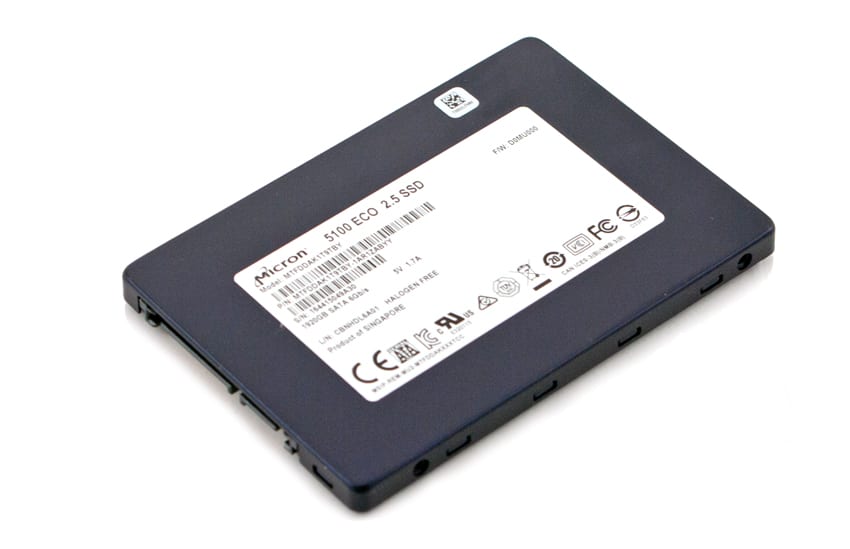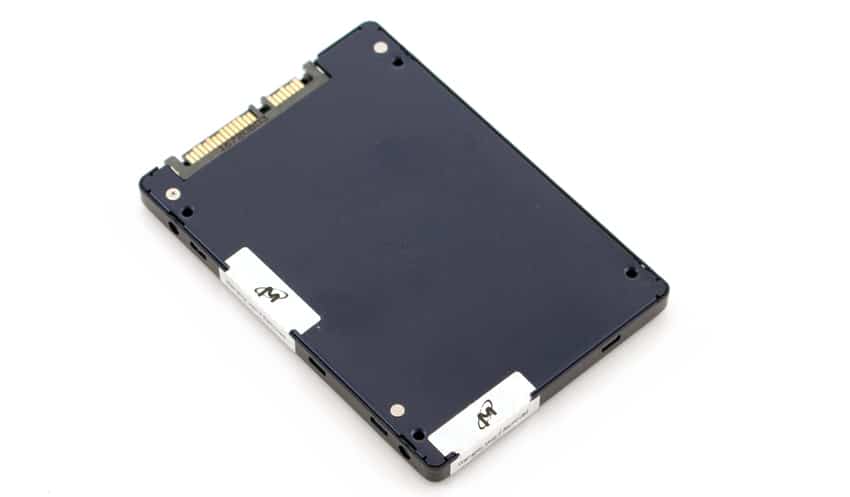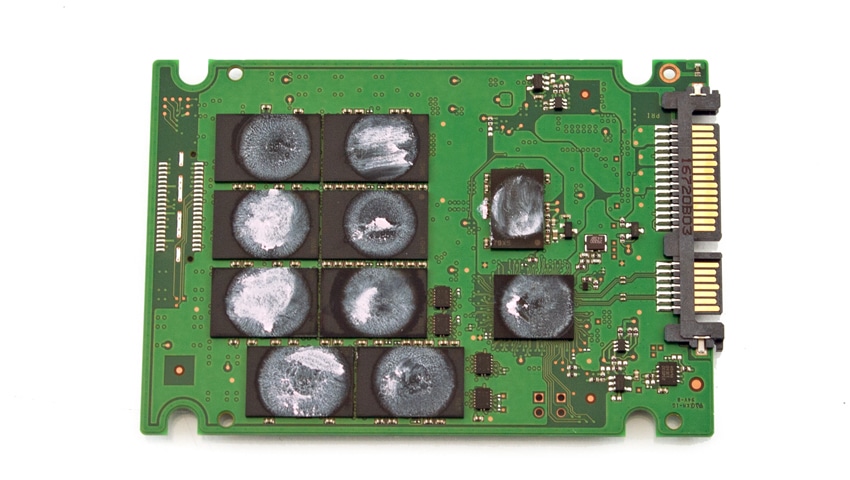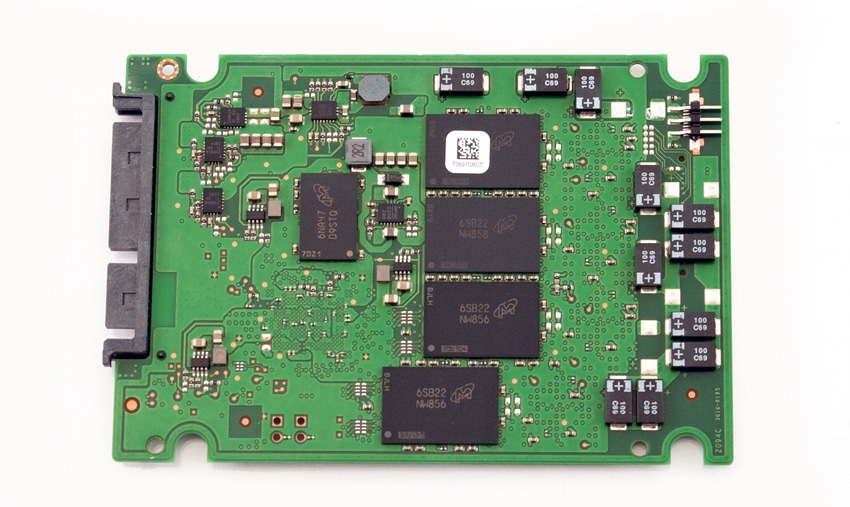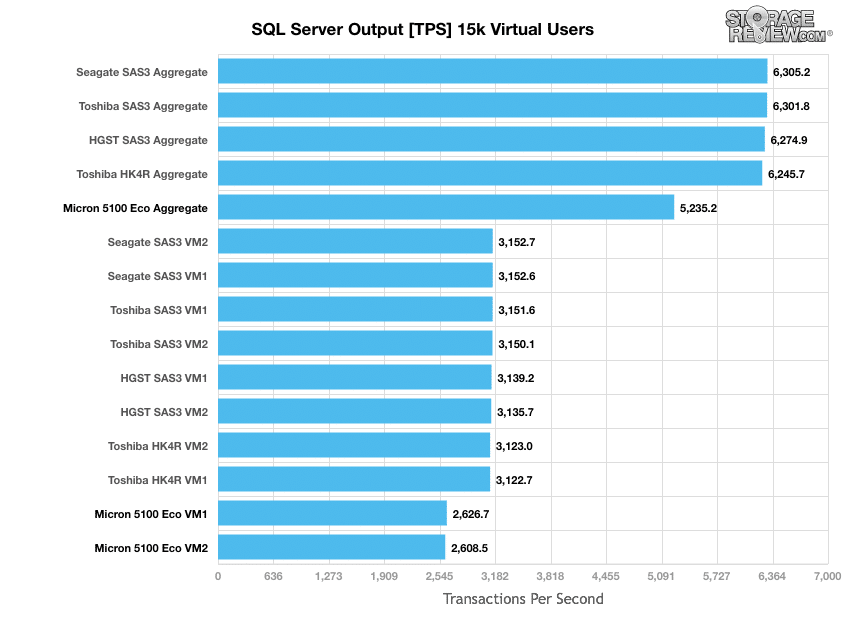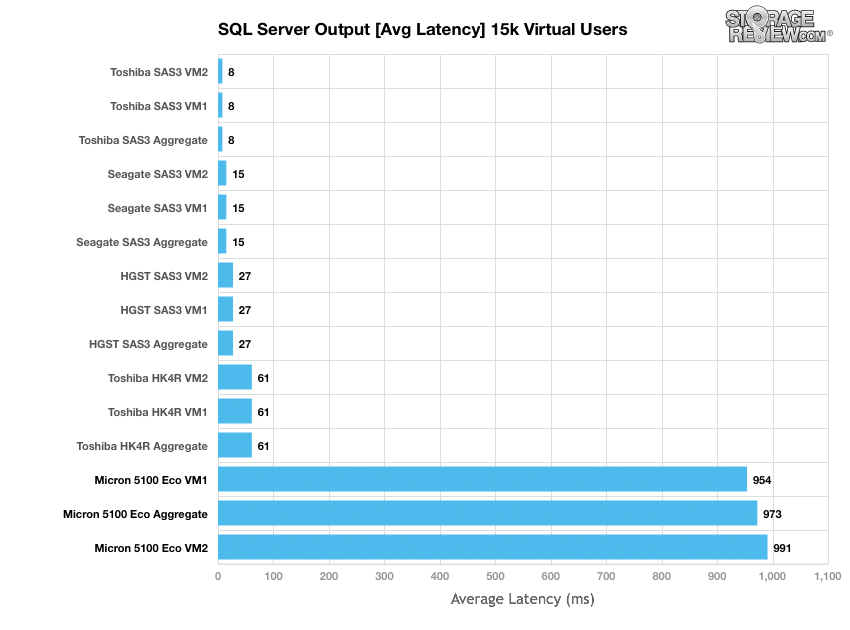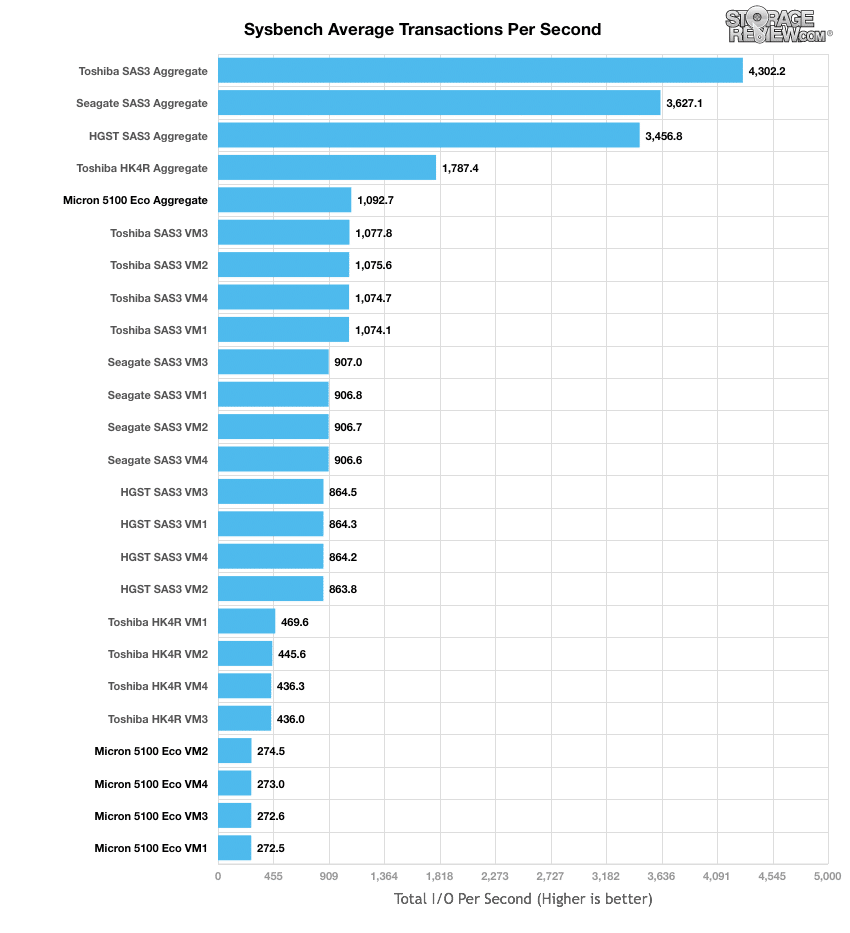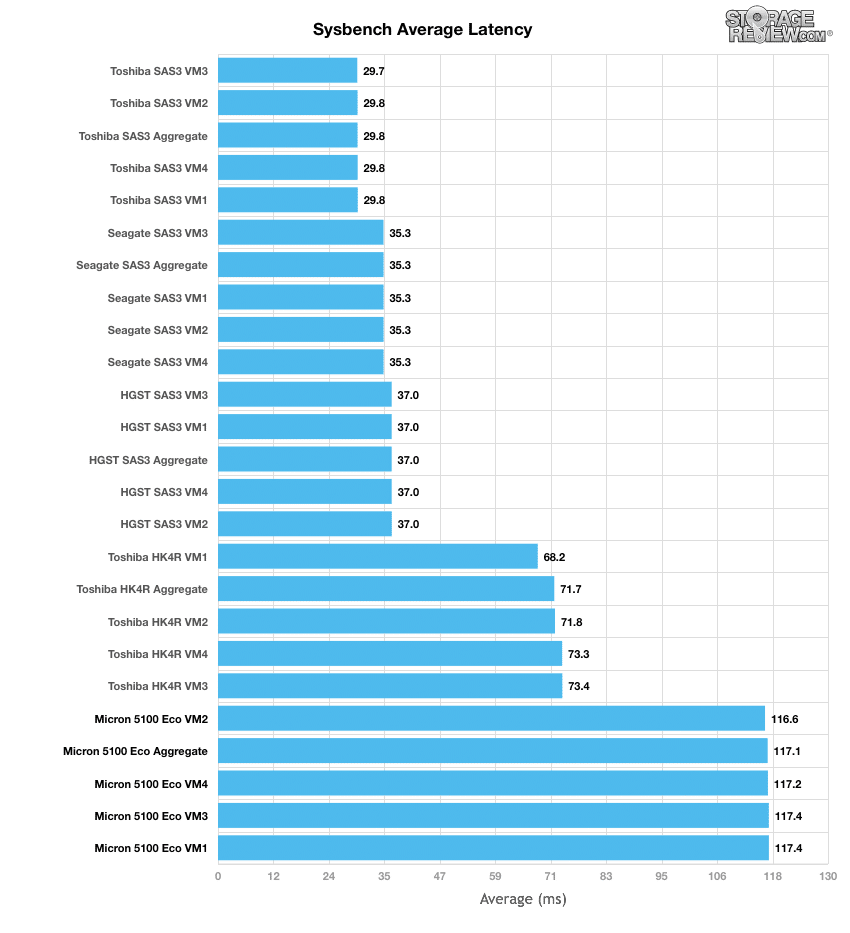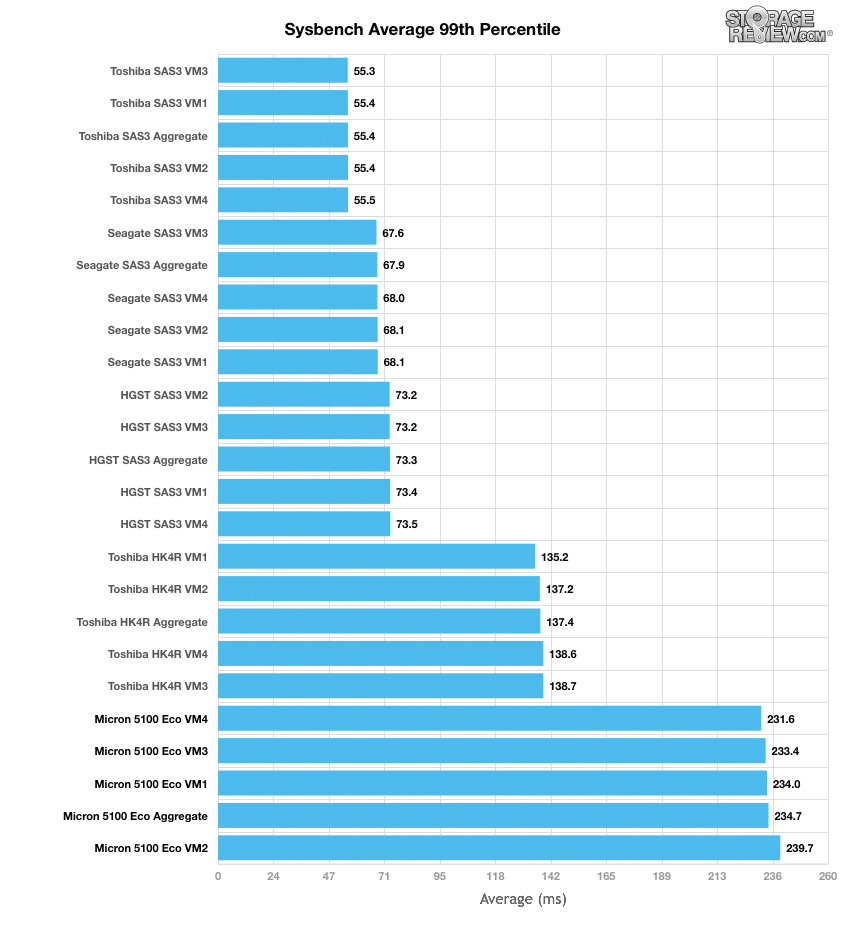
The Micron 5100 SSD family is the new series of SATA SSDs aimed at data-center adoption. Micron has released three flavors for specific use cases: the ECO for read-intensive workloads such as video streaming, the PRO for latency-sensitive transactional databases, and the MAX for write-intensive logging applications. All of the drives come in two form factors: 2.5-inch and M.2, and in capacities up to 8TB for the 2.5-inch and 2TB for the M.2.
For this review, we will be looking at the ECO or read-intensive drive. The 5100 ECO has several benefits that make it appealing to the data center. High capacity in a small form factor is an always-welcome benefit, as it keeps overall footprint down. As stated above, the 2.5” version runs up to 8TB and the M.2 can run up to 2TB. Micron is claiming consistent, steady state performance writes at 74K IOPS. From a security standpoint, the drives come with AED-256 bit encryption. The drive can be optimized to the workload by using Micron’s FlexPro firmware. The best use cases for the drive are Big Data, content delivery, database management, virtualized environments, and open compute.
For our review we will be looking at the 1.92TB, 2.5” model of 5100 ECO.
Micron 5100 ECO SSD specifications:
- Form factor: 2.5-inch, M.2
- NAND: Micron 3D eTLC
- Capacity
- 2.5-inch: 480GB, 960GB, 1.92TB, 3.84TB, 7.68TB
- M.2: 480GB, 960GB, 1.92TB
- Interface: SATA 6Gb/s
- Endurance
- DWPD: <1
- TBW: 0.45-8.4PB
- MTTF: 2M
- Performance
- Sequential read performance (128K): 540MB/s
- Sequential write performance (128K): 380-520MB/s
- Random read performance (4K): 93,000 IOPS
- Random write performance (4K): 9000-31,000 IOPS
Design and Build
The Micron 5100 ECO has the same typical design one has come to expect with data center drives. It has no bells or whistles; just a dark bluish case. On the top is the typical sticker with drive information such as name, branding, and capacity. The bottom of the drive is a solid blank with the tamper seals visible.
The case, like most Micron SSDs, pops apart with a little bit of effort. Underneath, one can see four Micron NAND packages and Micron controller on top.
On the flip side is the rest of the NAND packs and DRAM.
Testing Background and Comparables
The StorageReview Enterprise Test Lab provides a flexible architecture for conducting benchmarks of enterprise storage devices in an environment comparable to what administrators encounter in real deployments. The Enterprise Test Lab incorporates a variety of servers, networking, power conditioning, and other network infrastructure that allows our staff to establish real-world conditions to accurately gauge performance during our reviews.
We incorporate these details about the lab environment and protocols into reviews so that IT professionals and those responsible for storage acquisition can understand the conditions under which we have achieved the following results. None of our reviews are paid for or overseen by the manufacturer of equipment we are testing. Additional details about the StorageReview Enterprise Test Lab and an overview of its networking capabilities are available on those respective pages.
Comparables for this review:
As the capacity and performance for SATA and SAS drives increase, StorageReview has pivoted to a more aggressive testing regimen for individual SSDs. This testing process is mirrored across NVMe products as well, making the comparison process easier–even though products perform in vastly different classes at the top-end. In this review, we compare the 1.92TB Micron Eco to the 1.92TB Toshiba HK4R, as well as three additional SAS3 products that help set a high-performance reference point. As more drives come into the test lab with a capacity greater than 1.2TB, we will continue to add comparables into this group.
Application Workload Analysis
In order to understand the performance characteristics of enterprise storage devices, it is essential to model the infrastructure and the application workloads found in live production environments. Our first benchmarks for the Micron 5100 ECO are therefore the MySQL OLTP performance via SysBench and Microsoft SQL Server OLTP performance with a simulated TCP-C workload. For our application workloads, each drive will be running 2-4 identically configured VMs.
SQL Server Performance
Each SQL Server VM is configured with two vDisks: 100GB volume for boot and a 500GB volume for the database and log files. From a system resource perspective, we configured each VM with 16 vCPUs, 64GB of DRAM and leveraged the LSI Logic SAS SCSI controller. While our Sysbench workloads tested previously saturated the platform in both storage I/O and capacity, the SQL test is looking for latency performance.
This test uses SQL Server 2014 running on Windows Server 2012 R2 guest VMs, being stressed by Dell's Benchmark Factory for Databases. StorageReview’s Microsoft SQL Server OLTP testing protocol employs the current draft of the Transaction Processing Performance Council’s Benchmark C (TPC-C), an online transaction-processing benchmark that simulates the activities found in complex application environments. The TPC-C benchmark comes closer than synthetic performance benchmarks to gauging the performance strengths and bottlenecks of storage infrastructure in database environments. Each instance of our SQL Server VM for this review uses a 333GB (1,500 scale) SQL Server database and measures the transactional performance and latency under a load of 15,000 virtual users.
SQL Server Testing Configuration (per VM)
- Windows Server 2012 R2
- Storage Footprint: 600GB allocated, 500GB used
- SQL Server 2014
- Database Size: 1,500 scale
- Virtual Client Load: 15,000
- RAM Buffer: 48GB
- Test Length: 3 hours
- 2.5 hours preconditioning
- 30 minutes sample period
When looking at SQL Server Output, the 5100 ECO had individual VMSs running between 2,608.5 TPS to 2,626.7 TPS, for an aggregate score of 5,235.2 TPS. This places it last compared to the other drives, with the other SATA drive having an aggregate score of 6,245.7 TPS.
Average latency showed the 5100 ECO once again placing last, only by a much more considerable margin. Individual VMs ran between 954ms and 991ms with an aggregate score of 973ms. The HK4R had an aggregate latency of 61ms.
Sysbench Performance
The next application benchmark consists of a Percona MySQL OLTP database measured via SysBench. This test measures average TPS (Transactions Per Second), average latency, and average 99th percentile latency as well.
Each Sysbench VM is configured with three vDisks: one for boot (~92GB), one with the pre-built database (~447GB), and the third for the database under test (270GB). From a system resource perspective, we configured each VM with 16 vCPUs, 60GB of DRAM and leveraged the LSI Logic SAS SCSI controller.
Sysbench Testing Configuration (per VM)
- CentOS 6.3 64-bit
- Percona XtraDB 5.5.30-rel30.1
- Database Tables: 100
- Database Size: 10,000,000
- Database Threads: 32
- RAM Buffer: 24GB
- Test Length: 3 hours
- 2 hours preconditioning 32 threads
- 1 hour 32 threads
In the average transactions-per-second benchmark, the 5100 ECO had individual VMs running between 272.5 TPS to 274.5 TPS, for an aggregate score of 1,092.7 TPS–once again placing it last. The closest drive, performance-wise, was the HK4R with an aggregate score of 1,787.4 TPS.
Looking at average Sysbench VM latency, we measured individual VMs between 116.6ms and 117.4ms, for an aggregate of 117.1ms for the 5100 ECO. The Toshiba HK4R had an aggregate score of 71.7ms.
In terms of our worst-case MySQL latency scenario (99th percentile latency), the 5100 ECO was in last place, with individual VMs running from 231.6ms to 239.7ms with an aggregate score of 234.7ms. The other SATA drive in the mix, the HK4R, had an aggregate score of 137.4ms.
Conclusion
The ECO is the read-intensive model of Micron’s new 5100 family of data-center drives. This SATA drive comes in capacities up to 8TB for the 7mm 2.5” model and up to 2TB for the M.2 model. The drive has security features such as AES-256-bit encryption and users will be able to optimize the drive using Micron’s FlexPro firmware. According to Micron, the new drives are targeted for use cases such as Big Data, content delivery, database management, virtualized environments, and open compute.
Looking at performance, the 5100 ECO was at the bottom of the packs in each test we ran. To be fair, it is a SATA-based drive and three of the four comparables are SAS-based drives (this is due to the lack of test data we have on hand for SATA data-center drives). However, in each test, the 5100 ECO trailed far behind the Toshiba read-centric SATA SSD as well. In our SQL Server benchmark, the 5100 ECO had an aggregate TPS of 5,235.2 and an aggregate average latency of 973ms. Looking at Sysbench, the 5100 ECO had a TPS aggregate score of 1,092.7, an aggregate average latency of 117.1ms, and a worst-case scenario latency of 234.7ms.
The trick with the SATA SSD space sometimes is defining what exactly it's targeting. Broad targets like big data sound nice and make intuitive sense, but let's categorize it another way and think about the SATA SSD in a few key roles: server boot, in-server storage and capacity tier for SDS (think vSAN). In these cases, there are several important considerations, but performance isn't generally the top one or two or even three. In fact, in many scenarios, a SATA SSD will be the first line replacement for 10K and 15K HDDs that still dominate the performance/capacity story in the enterprise today.
In regards to the 5100 ECO specifically, it's not a great performer. However, it doesn't necessarily have to be. Booting an ESXi server isn't particularly hard, and running a clustered database that's considering SATA drives clearly isn't a performance-first operation. In vSAN, the goal is to have reads and writes hit the cache, and the capacity tier mostly just needs to be reliable and available. And just think about the object-store efficiency and TCO gains when pricing of the 8TB 5100 makes sense from an HDD replacement perspective. The key to success with this drive is going to be based on cost optimization, something Micron has a good deal of control over given the vertical integration. They've proven reliability over a very long term; now the drive needs to be cost-effective to justify the like-for-like replacement (with a sizable performance bump) over the legacy performance HDD business.
Pros
- Up to 8TB of capacity in a 2.5” drive
- Workload optimization with FlexPro firmware
- Offered in 2.5" and m.2 form-factors
Cons
- Poor performance across the board in our benchmarks
The Bottom Line
The Micron 5100 ECO is a data center drive with up to 8TB of capacity and a track record of reliability and stability, but lacks in performance compared to other read-centric SATA enterprise SSDs.
Sign up for the StorageReview newsletter

